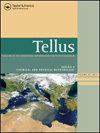Aerosol NO' 3 and 210Pb distribution over the central-eastern Arabian Sea and their air-sea deposition fluxes
IF 2.3
4区 地球科学
Q3 METEOROLOGY & ATMOSPHERIC SCIENCES
Tellus Series B-Chemical and Physical Meteorology
Pub Date : 1999-09-01
DOI:10.1034/J.1600-0889.1999.T01-3-00001.X
引用次数: 27
Abstract
The concentrations of NO − 3 , SO 2− 4 and 210 Pb have been measured in the marine boundary layer over the central-eastern Arabian Sea to investigate the sources of NO − 3 to this region and its deposition flux to the sea surface. Bulk aerosol samples were collected during April – May (intermonsoon) 1994, July – August (monsoon) 1995, 1996 and February – March (winter) 1995, 1997. The NO − 3 and 210 Pb concentrations, during the intermonsoon and winter, ranged from 0.4 to 4.1 μg m −3 and (12.3 to 70.3) × 10 −3 dpm m −3 , respectively; with systematically higher concentrations during the winter. Their concentrations were the lowest, 0.2 to 0.8 μg m −3 and (4.0 to 17.6) × 10 −3 dpm m −3 , respectively, during monsoon. The seasonal and spatial distributions of NO − 3 and 210 Pb in the aerosols show a significant positive correlation and bring to light the dominant ro le of continental sources in the chemistry of aerosols over the Arabian Sea. The NO − 3 deposition flux to the Arabian Sea surface is determined to be 0.9 mg m −2 d −1 based on the NO − 3 / 210 Pb ratio (43 μg/dpm −1 ) and the measured 210 Pb deposition flux of 20 dpm m −2 d −1 . The atmospheric NO − 3 flux to the mixed layer is insignificant compared to that fixed by primary production in this region and that supplied to the mixed layer from the base of the euphotic zone. The annual mean 210 Pb concentration (25 × 10 −3 dpm m −3 ) and its atmospheric deposition flux (20 dpm m −2 d −1 ) yield an effective deposition velocity of ∼0.9 cm s −1 for 210 Pb aerosols; similar to that used for deriving NO − 3 and NH + 4 deposition fluxes. The seasonal trend for SO 2− 4 concentrations is quite similar to that of NO − 3 , with the non-sea-salt component of SO 2− 4 being generally higher during the winter and the intermonsoon periods. DOI: 10.1034/j.1600-0889.1999.t01-3-00001.x阿拉伯海中东部地区气溶胶NO’3和210Pb分布及其海气沉积通量
通过对阿拉伯海中东部海相边界层NO−3、so2−4和210pb浓度的测定,探讨了该地区NO−3的来源及其向海面的沉积通量。1994年4 - 5月(季风间)、1995年、1996年7 - 8月(季风)和1995年、1997年2 - 3月(冬季)收集了大量气溶胶样本。季间期和冬季NO - 3和210pb浓度分别为0.4 ~ 4.1 μg m−3和(12.3 ~ 70.3)× 10−3 dpm m−3;在冬季有系统地更高的浓度。它们的浓度在季风期间最低,分别为0.2 ~ 0.8 μg m−3和(4.0 ~ 17.6)× 10−3 dpm m−3。NO−3和210 Pb在阿拉伯海气溶胶中的季节和空间分布呈显著正相关,揭示了大陆源在阿拉伯海气溶胶化学中的主导作用。根据NO−3 / 210 Pb比值(43 μg/dpm−1)和实测210 Pb沉降通量(20 dpm m−2 d−1),确定阿拉伯海表面NO−3沉降通量为0.9 mg m−2 d−1。大气NO−3向混合层的通量与该地区初级生产固定的通量和从光带底部向混合层提供的通量相比微不足道。210 Pb气溶胶的年平均浓度(25 × 10−3 dpm m−3)及其大气沉降通量(20 dpm m−2 d−1)产生的有效沉降速度为~ 0.9 cm s−1;类似于用于计算NO−3和NH + 4沉积通量的方法。so2−4浓度的季节变化趋势与NO−3非常相似,在冬季和季风间期,so2−4的非海盐成分普遍较高。DOI: 10.1034 / j.1600 0889.1999.t01 - 3 - 00001. x
本文章由计算机程序翻译,如有差异,请以英文原文为准。
求助全文
约1分钟内获得全文
求助全文
来源期刊
自引率
0.00%
发文量
3
期刊介绍:
Tellus B: Chemical and Physical Meteorology along with its sister journal Tellus A: Dynamic Meteorology and Oceanography, are the international, peer-reviewed journals of the International Meteorological Institute in Stockholm, an independent non-for-profit body integrated into the Department of Meteorology at the Faculty of Sciences of Stockholm University, Sweden. Aiming to promote the exchange of knowledge about meteorology from across a range of scientific sub-disciplines, the two journals serve an international community of researchers, policy makers, managers, media and the general public.

 求助内容:
求助内容: 应助结果提醒方式:
应助结果提醒方式:


